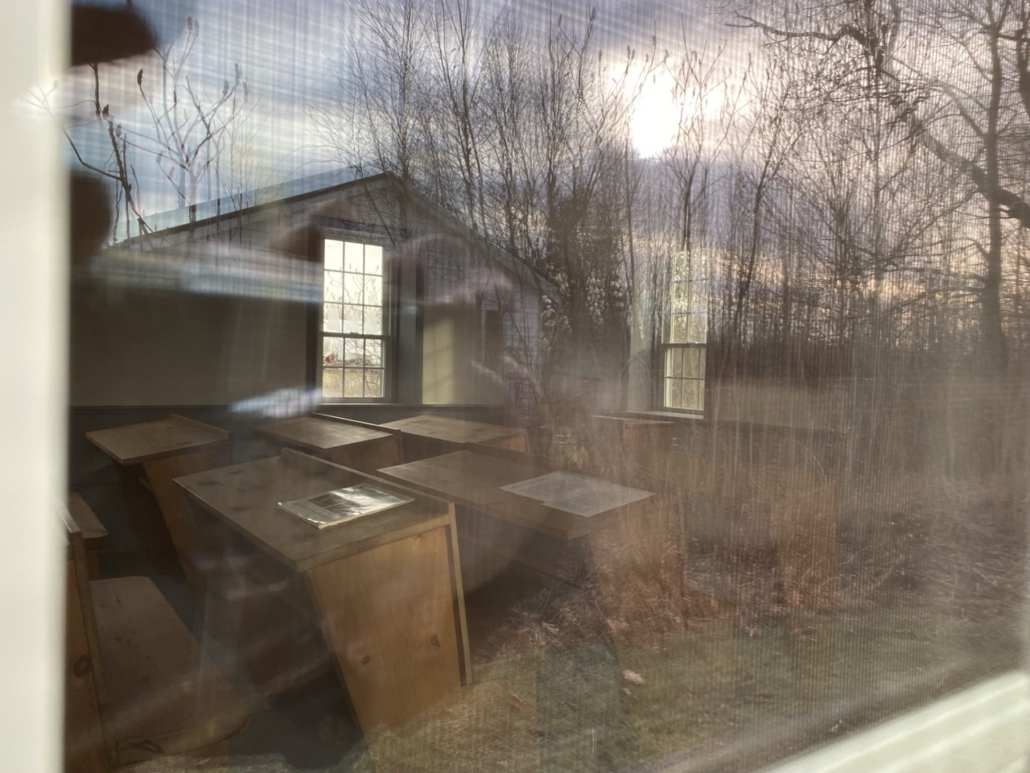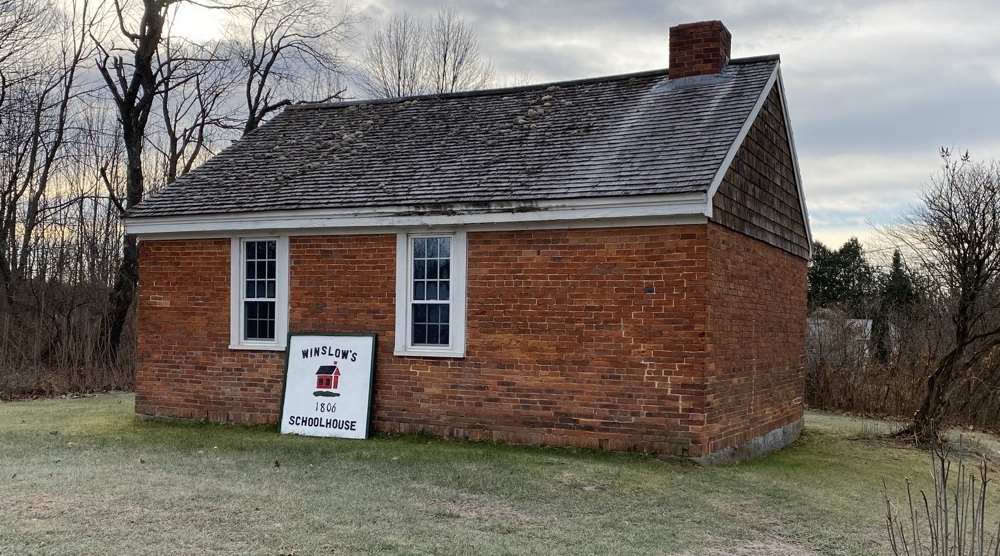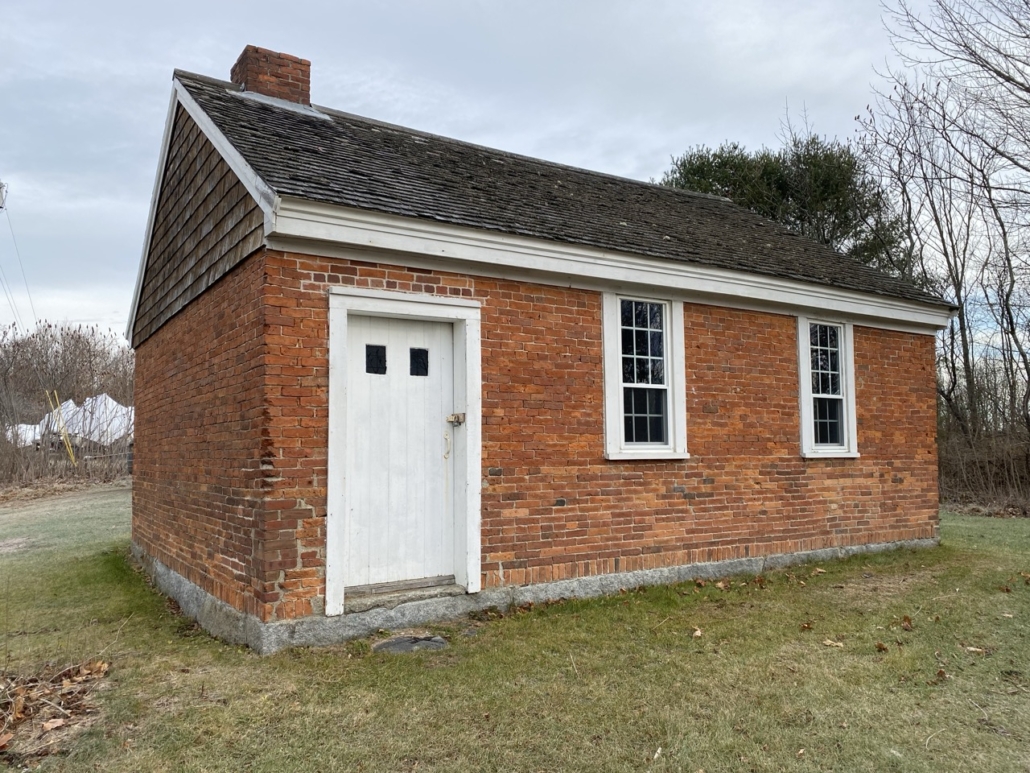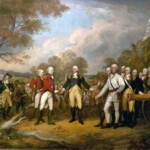Up and Down the Kennebec Valley: Education in Winslow Schools – Continued
by Mary Grow
This week’s article was to be a discussion of early schools in Fairfield, continuing the subseries on early education, but again your writer has been distracted. The first diversion, this week, is back to Winslow elementary schools, about which summary information was provided in the Nov. 7 issue.
Next week, yet another diversion will talk about a Waterville native who was an educator, among other careers. After that, Fairfield – maybe.
* * * * * *
Your writer is indebted to Tony Waraskevich, of Waterville, for reminding her about the Brick School, the Winslow schoolhouse still standing on the east side of Cushman Road (Route 32). It has been on the National Register of Historic Places since April 18, 1977.
A sign on the building dates it to 1806. The application for listing on the National Register says it was built between 1800 and 1820, listing as evidence:
— The lack of mention of the building in town records before a “hiatus” in record retention beginning in 1799; and
— An April 24, 1820, deed to the surrounding land that excludes “the ground on which the brick school house on the lot now stands, with the door yard.” This area “is hereby reserved for the use and occupation of School District No. 5 so long as said District shall keep the present brick school house in repair suitable to hold a school in and no longer.”
In a Dec. 9, 2014, Central Maine Newspapers article (found on line), staff writer Evan Belanger, citing “an architect,” narrowed the time to between 1800 and 1810. Belanger wrote that building a schoolhouse was a condition the State of Massachusetts imposed on settlers in Winslow under its Kennebec Valley Land Trust program for Revolutionary War veterans.
The building is a single story, nearly square, with a peaked shingled roof (Waraskevich says the shingles are cedar) and a shingled triangular wall under the roof on the east and west ends.
The Town Line editor Roland Hallee added that the bricks are made from mud from “a bog on what is now the Patterson Rd., off the China Rd.” A contemporary on-line map shows this dead-end road running south off China Road (Route 137) west of and across Outlet Stream from Cushman Road; the two are roughly parallel.
Henry Kingsbury commented in his Kennebec County history that “Good clay for making brick may be found in many places in Winslow.” As was his habit, he identified several of the places by 1892 landowners: Ira Getchell’s farm, Stephen Abbott’s house, the Hampden Keith place. Some were “near the river”: one was “near North Vassalboro.”
The brick schoolhouse stands on rough granite blocks barely visible above the sod. There are no windows on the west (road) side. On the north side are two rectangular windows; on the east side, two more plus a smaller one in the gable; on the south side, two more, with a narrow wooden door at the eastern end.
The door does not open directly into the schoolroom, but into a narrow entry, described as a coatroom in the application for historic listing, between the outer west wall and the rear wall of the classroom. The middle of the interior wall is occupied by a large open fireplace; its squat brick chimney rises above the ridgepole near the west end of the roof.
Frank Beard and Stephen Kaplan, in their application for historic listing, commented that “The woodwork around the fireplace reflects in a very restrained manner, the delicacy and low relief typical of Federal treatment.”
Later in the application, they wrote, “The Brick School testifies to early determination to provide public education and its staunch construction betokens a permanency which suggests that its builders contemplated a continuing commitment to this goal.”
The building is now owned by the Town of Winslow and managed by its Historical Preservation Committee. An early classroom is recreated inside.
Eight rows of double wooden desks face east, four on each side of a center aisle. The front of each desk, except those in the two front rows, forms the back of the seats in the row ahead.
Each seat is easily wide enough for two children, and should there be more than 16 students, a third could probably squeeze in.
At the east end of the room, the taller teacher’s desk faces the rows of student desks. There is a small table beside it.
Multiple sources say the building stopped being used as a schoolhouse in or before 1865. Its history is unknown for more than a century; it reportedly stood empty part of the time and was used for storage at other times.
In 1972, the Winslow Historical Society acquired it, and in the 1990s invested more than $20,000 in rehabilitation.
Belanger wrote that Francis Giddings owned the brick school for many years. When the Historical Society disbanded late in the 1990s, his grandchildren became owners of the building.
They offered it to the town, instead of paying around $200 in back taxes. At that time, the schoolhouse was estimated to need up to $13,500 in immediate masonry work “using historically accurate methods” (the cost would be considerably less with modern methods). In addition, Belanger said, Councilor Raymond Caron, who had been a Historical Society member, recommended setting aside another $1,000 to $2,000 for ongoing maintenance.
After a couple months’ discussion among town and school officials, the town council voted unanimously to accept the former school, and the Historical Preservation Committee became its guardian.

Despite the reflection in the window of the house next door, a period replica of the school room can be seen. (photo by Roland D. Hallee)
* * * * * *
Waraskevich listed three more former brick elementary schoolhouses in Winslow, all now demolished:
— A one-story building that stood “[b]etween the now closed Junior High School (original Winslow High School built in 1928) and the active Winslow High School/ Junior High School on Danielson Street.” Its site is now a parking lot.
— A two-story building, the Boston Avenue School, “[n]ear the present elementary school, north of the High School.”
— Another two-story building “[o]n Halifax Street, diagonally across the street from Monument Park…called the Halifax Street School.” Waraskevich said he did not know whether this school was built in 1915 after the “wooden 3-story high school building near there burned in 1914.” The site of the Halifax Street School is now “a playground for kids in the neighborhood.”
Waraskevich also mentioned St. John Regional Catholic School, which your writer ignored because it was “too modern” – early 20th century almost to the present. The school opened in 1927 in St. John the Baptist Church, on Monument Street, in Winslow; moved into a separate school building on South Garand Street in 1960; and closed at the end of the 2019-2020 school year.
An article in the Jan. 23, 2020, issue of The Town Line quoted Marianne Pelletier, then the superintendent of Maine Catholic Schools: “The sad truth is that rising costs, a decline in school-aged children in the Waterville/Winslow area, and an increased demand for financial assistance made it unfeasible to keep the school open.”
An on-line source says Pelletier retired at the end of the 2023-24 school year, after five years as superintendent. Her successor, Shelly Wheeler, was “raised in Vassalboro,” and her career in education included teaching math in Winslow.
Main sources
Beard, Frank A., and Stephen Kaplan, National Register of Historic Places Inventory – Nomination Form, The Brick School, Oct. 22, 1976
Kingsbury, Henry D., ed. Illustrated History of Kennebec County Maine 1625-1892 (1892)
Waraskevich, Tony, emails
Websites, miscellaneous
Responsible journalism is hard work!
It is also expensive!
If you enjoy reading The Town Line and the good news we bring you each week, would you consider a donation to help us continue the work we’re doing?
The Town Line is a 501(c)(3) nonprofit private foundation, and all donations are tax deductible under the Internal Revenue Service code.
To help, please visit our online donation page or mail a check payable to The Town Line, PO Box 89, South China, ME 04358. Your contribution is appreciated!






Leave a Reply
Want to join the discussion?Feel free to contribute!